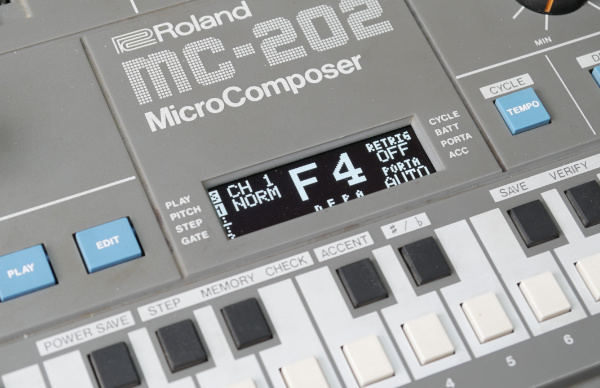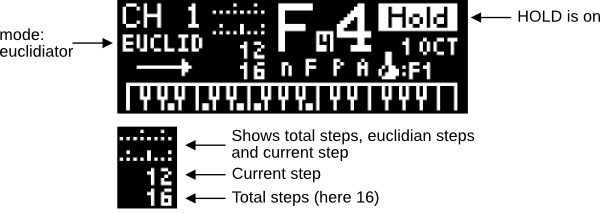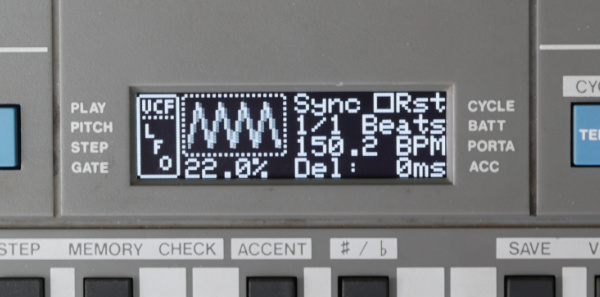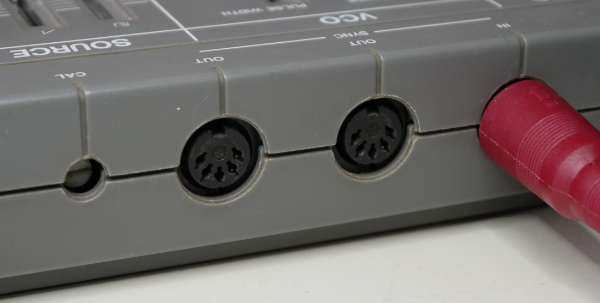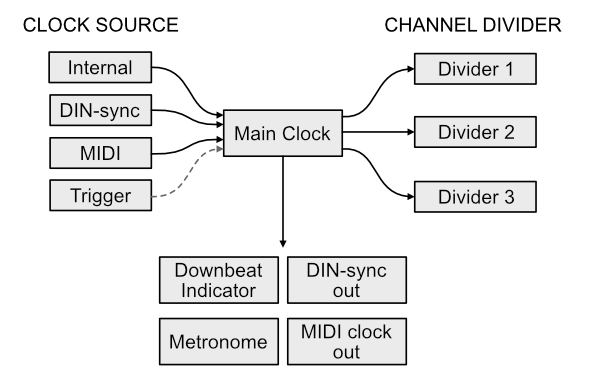Introduction
MC-2oh2 is an upgrade and feature extension for the Roland MC-202 synthesizer / composer.
It replaces the original CPU, keyboard PCB and display of an MC-202.
MC-2oh2 introduces a completely new control scheme for MC-202 synthesizers.
The sound however stays the same and many additional features are added.
Also compatible with the ‘DIN-SYNC RE-202’ project
Features
- Optimized for live performance, turns your 202 into a ‘groove box’.
- Three completely independent synthesizer control channels:
The internal synth, the 2nd CV/gate output and a 3rd MIDI out or DRUM channel. Each channel has its own clock divider and MIDI input and output. - Can be clocked via MIDI, DIN-sync or trigger using the TAPE-input
- Versatile sequencer with 32 patterns, chainable in song mode, edit patterns and songs while playing, shortcuts for quick live arrangement. Seven sequencer play directions.
- Sequence editor with copy, paste, insert and delete options, can modify note pitch, length and note-modifiers on the fly
- Arpeggiator with multiple octaves, seven direction modes including ‘order of key press’. Can inherit the ‘chemistry’ of existing sequences, optional euclidian mode and live shortcuts.
- Additional modulations: Accent, Filter and PW envelopes
- Additional noise sound with envelope.
- 8-bit LOFI drum sample output with various sound modifiers, sample packs can be uploaded via MIDI
- Save and recall up to 8 sets containing sequencer and modulation parameters. No batteries needed
- MIDI CC control of all additional parameters, filter cutoff, pulse width, clock dividers and more.
- Midi velocity can be linked to various sound parameters.
- Various CV-input modes including a ‘direct’ mode.
- Optional HiRes version of MC-2oh2 allows pitch bend control and microtonal tunings.
- High quality OLED display
- Firmware update via MIDI sysex
A detailed guide and list of all features can be found in the user guide.
Some features in more detail
Multiple channels
MC-2oh2 features a layered architecture with three completely independent synthesizer channels:
- Channel 1, the internal synthesizer
- Channel 2, the “external” synthesizer
- Channel 3, used for drum sounds or for an additional external midi synthesizer
At any moment, you can switch to a different channel shown on the display and tweak settings of that particular channel. The other channels will continue to function – the arpeggiator or sequencer keeps running and it is still possible to play other channels via midi.
Note properties
In the MC-2oh2 each note has a pitch, one of 5 possible lengths (including rest) and one or more of the following modifiers that further manipulate the sound:
- Accent: Triggers the MC-202 accent envelope
- Filter Accent: Triggers the MC-202 or additional MC-2oh2 accent envelope
- Portamento: Triggers portamento
- Noise: Triggers the noise sound with its own envelope
Sequencer
MC-2oh2 features a pattern based step sequencer with 32 patterns that can be chained to a song. The sequencer is optimized for live performance: You can change the playing pattern, edit a pattern, program a song and much more while playing without losing sync.
The pattern editor allows you to modify, copy, paste or move notes and their modifiers
Arpeggiator
A powerful arpeggiator with seven directions and multiple octaves.
The directions include a mode which plays the notes in the order they are pressed. This allows you to program little sequences on the fly.
The arp can inherit the note properties (length, modifiers, etc) of patterns, which allows dynamic and rhythmic arp sequences.
The arpeggiator also has an euclidian mode (Euclidiator) that enables further rhytmic structures.
Modulations
Many additional modulation sources for filter and pulse width are available. These are controllable via the config menu and MIDI CC:
- Filter accent: Triggers when a note has only filter accent, adjustable amount, attack and decay
- Filter ADSR: An additional filter envelope with delay, looping and invert functioniality
- Filter LFO: An additional filter LFO with multiple waveform, frequency between 0.1Hz and 1Khz, syncable to clock, lfo delay and reset functionality.
- Pulse width ADSR: An additional filter envelope with delay, looping and invert functioniality
- Pulse width: An additional filter LFO with multiple waveform, frequency between 0.1Hz and 1Khz, syncable to clock, lfo delay and reset functionality.
Drums and Samples
The 3rd channel can be used to program and play LO-FI drum and other samples.There is audio output via Tape-OUT jack or the internal speaker. The samples can be uploaded via MIDI sysex.
Note that the sample feature is fun, but limited. Only one sample can be played at a time, samples are of low quality and there is only a limited number of ways to modify the samples. Use this feature or don’t, just don’t expect a full high quality sampling engine 😉
Samples can be modified using Accent, reverse, double speed or half speed modifiers.
Noise
Compared to other classic synths the MC-202 was always lacking a noise waveform – until now. With each note you can trigger a noise sound with a custom envelope – or turn noise on forever. Noise is mixed with the other existing waveforms (saw, rect and sub) and goes through the filter. You can also adjust the noise sampling rate, ranging all the way from pure white noise to crunchy LOFI bubbling.
MIDI control
MC-2oh2 features MIDI in and output using the existing DIN-sync sockets on the back. The sockets keep functioning as DIN-sync as well.
Each of the thee channels can be controlled via midi and each channel has its own midi output sending sequences and arpeggios. There is also an additional ‘keyboard’ channel that allows you to play other midi gear via the MC-2oh2 keyboard.
Filter cutoff, pulsewith and all of the additional parameters and modulations can be controlled via midi CC. Midi velocity of incoming notes can be linked to filter cutoff, envelope parameters, accent and more.
Sets
Sequencer data, as well as additional modulation parameters can be saved as a set. Up to eight sets can be saved in MC-2oh2 and can be recalled easily.
Sets can also be transferred using MIDI sysex to be stored or manipulated outside the MC-2oh2.
Defective Records have created MC-2oh2-Hack – a software for PC and MAC that uses these features and let’s you edit MC-2oh2 sequences, modulation parameters and allows sample upload.
User guide
The latest user guide is available as PDF here.
It contains a quick start guide, describes the basic MC-2oh2 philosophy and approach and explains all features in detail.
There is also a “cheat sheet” for all features. (Best to read the user manual before looking at this)
There will also be a tutorial video.
Installation guide
An installation guide as PDF can be found here.
A video showing the installation is here. This video is only meant as an additional guide, always use the installation manual!
MC-2oh2 replaces the original MC-202 CPU and the MC-202 keyboard/display board.
In order to perform the installation one needs SMD soldering skills and tools. We have a list of synth-techs who are able to perform the installation (ourselves included):
MC-2oh2 synth-tech list.
If you want to perform the installation yourself, please carefully read the installation guide first. Generally if you have the required tools and have soldered fine pitch (1mm) SMD before you might be able to perform the installation. Be aware that Tubbutec does not take any responsibility for damage caused by an incorrect installation.
Frequently asked questions
Q: I have a couple of mods done to my 202, will they interfere with the mod?
A: Usually these modifications are purely analogue and will not interfere with the mod, however there might be exceptions, such as the case below.
The following mods should not cause any issues:
– Extra CV-inputs such as: Filter, PW, VCA, MOD, …
– Extra audio input for the filter or similar
– Extra outputs: Such as waveforms
– Extra modulation (Filter modulation for example)
– LFO speed mods, accent trigger, etc…
Q: My 202 has the the ‘direct CV-in’, does this interfere with the mod?
A: This depends on how this mod was done. Can you switch the direct CV on and off? Then you don’t need to worry. If however the external CV is hardwired to the VCO, completely severing the connection to the CPU, it does not have any control. You would not be able to use the sequencer.
In such a case you’d need to reverse this modification or change it into a switchable type.
Rule of thumb: if you can use your 202’s sequencer, all is fine.
Q:How does current draw differ with the new display? Does it affect battery life?
A: Current draw of the original MC-202 is about 100mA, with MC-2oh2 it is about 120mA. So battery life is affected a bit. On the other hand: The original needed a standby mode to save sequencer data. This is not needed for the MC-2oh2, you can just turn it off after saving a set. So you save battery live when turned off.
A: MC-2oh2 offers two CV-in modes which are selectable in software:
– True direct CV-mode. CV-in is directly passed to the VCO. CPU, does not have any control over the pitch
– Quantized mode: CV-in is read via an ADC (analog to digital converter), quantized and then passed to a DAC (digital to analog converter). However by using a different ADC, MC-2oh2 can do this much faster then the original. There is no significant lag.
Q:Do I really also need the new display? Does this work with the original display?
A: We did in fact start developing MC-2oh2 with support for the original display in mind. However it is nearly impossible to convey the amount of information the new features bring on the simple original display.
Q:Are there display colors other than white?
A:We can provide blue, green or yellow displays on request. They will be slightly more expensive and lead times may be longer.
Q:Are there any limitations compared to the original MC-202
A: It is mostly difficult to compare the features as the approaches are so different. In the original MC-202, the step length for each note can be different. In MC-2oh2, the step length is fixed, only the gate length can be varied.
Q:Are there plans for updates?
A: We have a lot of ideas how to further improve MC-2oh2 and add new features. We will add features eventually and if there is time. Bugs on the other hand will of course be fixed asap. Firmware update is possible via MIDI sysex.



